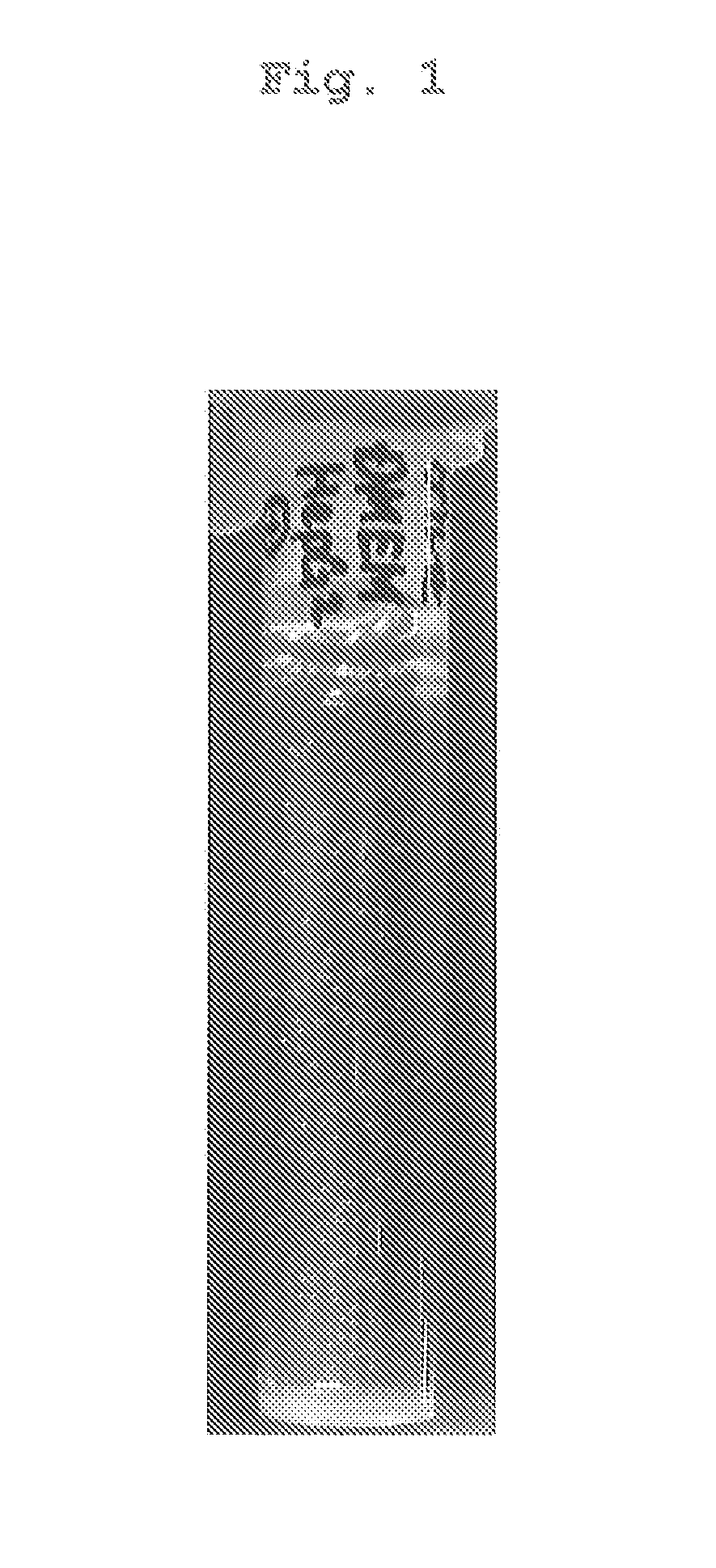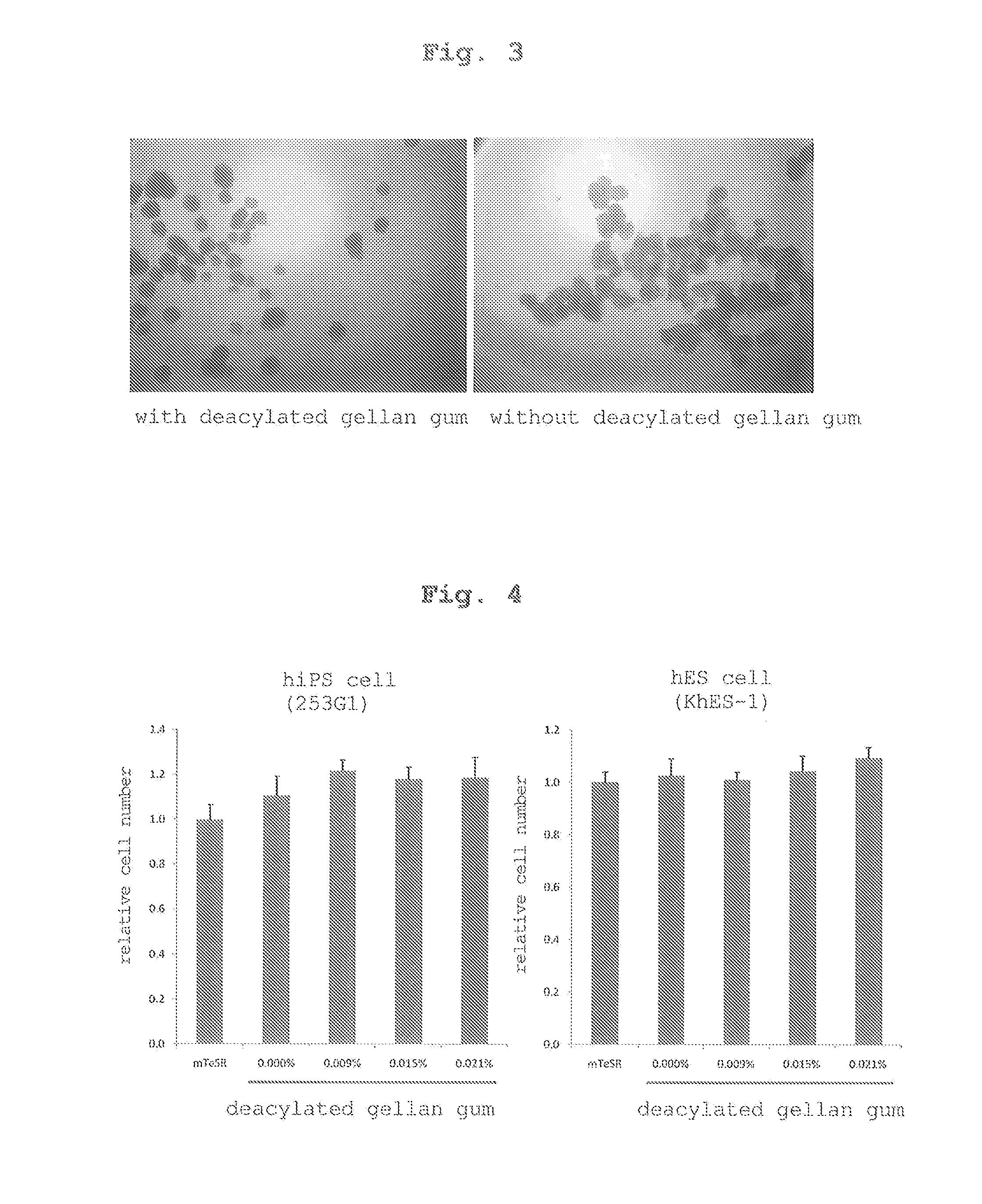Culture medium composition and method of culturing cell or tissue using thereof
a technology of culture medium and composition, which is applied in the field of culture medium composition and method of culturing cell or tissue using thereof, can solve the problems of inability to maintain specific functions of cells, difficulty in culturing and sometimes the method of cultivating the object cell on feeder cells is not suitable, so as to achieve easy exchange, easy recovery of cultured cells and/or tissues, and the effect of avoiding impairing the function
- Summary
- Abstract
- Description
- Claims
- Application Information
AI Technical Summary
Benefits of technology
Problems solved by technology
Method used
Image
Examples
example 1
Analysis Example 1
Viscosity Measurement and Cell Suspension Test of Medium Containing Deacylated Gellan Gum
Preparation and Viscosity Measurement of Deacylated Gellan Gum-Containing Medium
[0190]Deacylated gellan gum (KELCOGEL CG-LA, manufactured by SANSHO Co., Ltd.) was suspended in pure water to 0.4% (w / v), and dissolved by stirring with heating at 90° C. This aqueous solution was allowed to cool to room temperature with stirring, and sterilized at 121° C. for 20 min in an autoclave. A 2-fold concentration of DMEM / F-12 medium (manufactured by Aldrich, 50 mL) and sterilization water (47.5 mL) were placed in a 300 mL tall beaker with stirring by a homomixer (3000 rpm) at room temperature, aqueous deacylated gellan gum solution (2.5 mL) was added, and the mixture was continuously stirred for 1 min to prepare a deacylated gellan gum medium composition with a final concentration of 0.01%. Medium compositions added with aqueous deacylated gellan gum solution with final concentrations of 0...
experimental examples
[0195]While the usefulness of the medium composition of the present invention in cell culture is concretely explained in the following Experimental Examples, the present invention is not limited thereto alone. The CO2 concentration (%) in a CO2 incubator was shown by % volume of CO2 in the atmosphere. PBS means phosphate buffered saline (manufactured by Sigma Aldrich Japan), and FBS means fetal bovine serum (manufactured by Biological Industries). In addition, (w / v) shows weight per volume.
experimental example 1
Cell Proliferation Test by Dispersing Single Cell
[0196]Deacylated gellan gum (KELCOGEL CG-LA, manufactured by SANSHO Co., Ltd.) was suspended in ultrapure water (Milli-Q water) to 0.3% (w / v), and dissolved by stirring with heating at 90° C. This aqueous solution was sterilized at 121° C. for 20 min in an autoclave. Using this solution, a medium composition was prepared by adding deacylated gellan gum at a final concentration of 0.015% (w / v) to IMDM medium (manufactured by Gibco) containing 10% (v / v) fetal bovine serum and 10 ng / mL thrombopoietin (manufactured by WAKO). Successively, human leukemia cell line UT7 / TPO was plated on a medium composition added with the above-mentioned deacylated gellan gum to 20000 cells / mL, and dispensed to a 6-well flat bottom microplate (manufactured by Corning Incorporated) at 5 mL / well. Similarly, human cervical cancer cell line HeLa (manufactured by DS PHARMA BIOMEDICAL CO., LTD.) was plated at 20000 cell / mL on a medium composition obtained by addi...
PUM
| Property | Measurement | Unit |
|---|---|---|
| viscosity | aaaaa | aaaaa |
| pore size | aaaaa | aaaaa |
| size | aaaaa | aaaaa |
Abstract
Description
Claims
Application Information
 Login to View More
Login to View More - R&D
- Intellectual Property
- Life Sciences
- Materials
- Tech Scout
- Unparalleled Data Quality
- Higher Quality Content
- 60% Fewer Hallucinations
Browse by: Latest US Patents, China's latest patents, Technical Efficacy Thesaurus, Application Domain, Technology Topic, Popular Technical Reports.
© 2025 PatSnap. All rights reserved.Legal|Privacy policy|Modern Slavery Act Transparency Statement|Sitemap|About US| Contact US: help@patsnap.com



